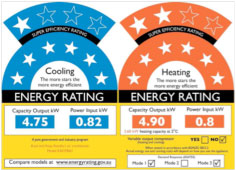- NZ Home
- Product Overview
- Our Brands
- Spare Parts
- Tech Info
- Selection Programs
- Warranty
- Price
- About Us
- Contact
Understanding Star Ratings
Products
Brands
Quick Links
- www.hitachiaircon.co.nz Hitachi Heat Pump Website
- temperzone NEWS Find out what's new
- Gen. Conditions of Sale What are they?
- Account Application Apply for a credit account
- Energy Rating/MEPS Compliance. Search & compare
- Our Australian Trade Site What's available in Oz?
- Can't Open Links? Web browser compatibility
Star labels must be displayed on all heat pumps sold in New Zealand and are supposed to show in an easy visual way how efficient each heat pump is.
Unfortunately the rules for determining star ratings have changed a couple of times recently, causing a lot of confusion. If you compare two heat pumps under different scales of star ratings you will get a misleading picture. This document is written help explain the changes and make star ratings easier to interpret.
How are star ratings determined?
Like many electrical devices, heat pumps have a set of regulations they must comply with. These are called the Minimum Energy Performance Standards (MEPS). The MEPS standards set out a number of things, including what appliances can and can’t be sold (heat pumps can’t be sold in NZ unless they meet the minimum standard), how to test the heat pumps performance and how to display that performance. This encompasses the energy rating “star labels” you see on heat pumps.MEPS regulations are determined by the Australian government, and New Zealand adopts the same standards.
Why did the energy rating “star labels” have to change?
Due to recent increased environmental awareness, MEPS standards for heat pumps have been rapidly rising over the last few years, and there are already regulations in place that will take effect in the future. These constantly changing regulations mean that many heat pumps are no longer able to meet the minimum standards, and have to be replaced by newer, more efficient models.At the same time, because the new heat pump models are more efficient the labelling also needed to change to keep up. If the labelling didn’t change every new heat pump would have the maximum number of stars, and you would no longer be able to tell their performance apart.
| What was the “old” star system and when does it finish? The “old” star system had a maximum score of 6 stars, and was laid out with the cooling stars (in blue) on the outside and the heating stars (in red) on the inside. To work out the number of stars the running efficiency (EER for cooling & COP for heating) was used. The regulations allowing this star labelling finished on 31 March 2010, and were replaced by the new regime as below. Unfortunately there are still many labels and brochures that have not yet been updated and are still using this system. Retailers and agents displaying old star ratings are misleading you, and are liable to have action taken against them by EECA. |  |
| So what is the “new” star system and how do I tell it apart form the old one? The “new” star system was mandatory from 1 April 2010, and is quite easy to tell apart from the old label, because now cooling and heating each have their own part of the label positioned side by side.The other major change is that the maximum numbers of stars possible is now 10. The top 4 stars are positioned as a “crown” on the most efficient units.Behind the scenes, manufacturers also now need to take in to account both the running efficiency and the standby power consumption to calculate the number of stars a unit gets. This gives an estimated annual running cost – so you should also notice a change in the efficiency figures given by manufacturers on their brochures. These will now be entitled AEER and ACOP to confirm they are “annualised” efficiency figures. |  |
So how do I compare the “old” stars to the “new” ones?As mentioned above, the old and new way of calculating stars is different, so unfortunately a direct comparison isn’t possible.Below is a table we have constructed, that approximately compares old and new stars as close as is possible.
"Old" star rating up to 31 March 2010 "New" star rating after 1 April 2010
"Old" star rating up to 31 March 2010 "New" star rating after 1 April 2010
"Old" star rating up to 31 March 2010 | "New" star rating after 1 April 2010 |
2.5 | 0.5 |
3 | 1 |
3.5 | 1.5 |
3.5 | 2 |
4 | 2.5 |
4 | 3 |
4.5 | 3.5 |
4.5 | 4 |
5 | 4.5 |
5 | 5 |
5.5 | 5.5 |
5.5 | 6 |
6 | 6.5 |
6 | 7 |
6 | 7.5 |
6 | 8 |
6 | 8.5 |
6 | 9 |
6 | 9.5 |
6 | 10 |
